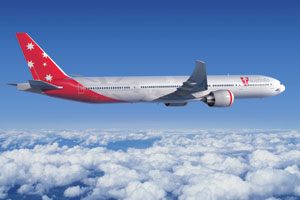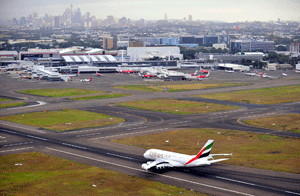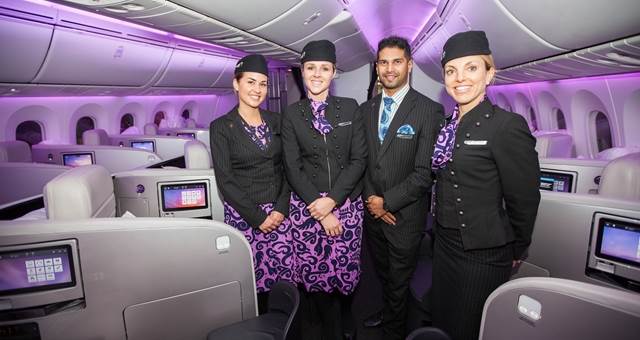By James Wilkinson
While the aviation market is struggling in some corners of the globe, it continues to boom in Australia, with new flights on the agenda for many of the world’s leading airlines.

V Australia launches Sydney-Los Angeles on Feb 27
When Qantas, Singapore Airlines and Emirates first ordered the Airbus A380 superjumbo in 2000, the aviation industry was in a very different place to where it is now. First there was September 11, then the collapse of Ansett, SARS, a second Gulf War and now the global economic meltdown.
Though all this, these three airlines have remained strong and have expanded to new levels, particularly over the last 18 months. They do have a number of major things in common – such as fleets and route network – but what’s in the spotlight right now are two things, the Airbus A380 and the Kangaroo Route.
When the first Emirates A380 touched down at Sydney’s Kingsford Smith Airport on the morning of February 2, it signalled the start of a new air-war. From this day, all three airlines to operate the superjumbo would be flying the Sydney-London route, one of the most competitive on the planet.
Each configured differently, Qantas opted for a four-class A380, while Singapore Airlines and Emirates went for the standard three-class model. But with corporate belts being tightened, some aviation insiders have questioned the move to leave out a premium economy offering – something many airlines are currently generating increasing revenue from.
As Qantas, Emirates and Singapore Airlines continue to receive the A380s they have on order, the aviation market becomes all the more competitive. The three airlines have a combined 103 superjumbos on order – the most being Emirates with 58 – and what the industry will see in four years time is a massive case of over-capacity should the current travel downturn continue.
Currently, there are only 13 A380s operating commercially, with another 185 still awaiting construction and delivery to 15 major carriers in total. Averaging 480 seats per plane, that’s 95,000 seats from one new model of aircraft entering service globally.
With the A380 in its early days of operation, the full-impact of the aircraft’s arrival is several years away from being felt. But it has already had a significant effect on the Australian tourism industry.
More capacity means more seats and for hoteliers that equals more hotel rooms being booked across Australasia, particularly in landing slot-restricted cities such as Sydney.
Orient-Express Hotels Regional Managing Director Patrick Griffin said the growth in the aviation market at present is extremely important.
“Without the means to bring the tourists to Australia, at a time they wish to travel and at a cost they are prepared to pay, the industry would have a bleak future,” he said.
“While it appears that merger talks between Qantas and British Airways have been shelved for now, there is promising aviation news on Australia’s horizon and thankfully the expansion plans will benefit our key source markets of the US, UK and Far East,” Griffin told HM magazine.
The A380 is not just making an impact on inbound tourism from the UK, Asia and the Middle East, but the city where Qantas first flew the superjumbo to – Los Angeles.
Qantas is now operating regular A380 services to Los Angeles from both Sydney and Melbourne. The trans-Pacific route is one of Qantas’s most lucrative and the decision to operate the aircraft to Los Angeles instead of London is proving to be substantial.
The airline picked up enormous publicity on the Australia-Los Angeles route right as Virgin Blue’s new international carrier V Australia was forced to postpone its launch flight from Sydney by over two months due to the Boeing machinists’ strike in Washington State.
V Australia will have its chance in the spotlight come February 27, when the inaugural flight takes off from Sydney to Los Angeles, marking the first time a second Australian airline has flown the route. It also breaks the duopoly Qantas and United have had for the past five years.
“Such an increase in competition on the Pacific Route is essential to the health of Australian tourism,” Griffin said.
Many hoteliers joined the chorus for more competition on the trans-Pacific run – including opening it up to Singapore Airlines – before the Federal Government made the decision to ban foreign owned carriers from the route.
The increase in competition is already paying a dividend, with V Australia reporting good bookings so far.
Virgin Blue general manager, sales and distribution, Mathias Friess told HM there have been a number of large group bookings for V Australia, which is meeting expectations for the new airline.
But, just around the corner, further competition awaits. Delta Air Lines commences daily Atlanta-Los Angeles-Sydney flights from July 1, 2009, using Boeing B777-200LR aircraft.
The arrival of Delta means millions more American frequent flyers will have easy access to the Australian market on the airline’s new long-haul product, which has been impressing travellers across North America.
As new airlines arrive on the trans-Pacific route, one departs. Air Tahiti Nui announced in late 2008 that it suspend direct flights between Sydney and Papeete from April 2009 and instead code-share via Auckland with Qantas.
“This decision has been made as a result of the ongoing global economic crisis,” said Air Tahiti Nui Regional Director – Australia, Craig Lee.
“This reduction in flights is part of a broader programme to cut costs worldwide during the northern summer schedule period, while continuing to offer passengers the ability to fly with us to Tahiti.”
Air Tahiti Nui had been offering one-stop flights between Sydney and Los Angeles and New York via Papeete. The news of the suspended flights came just days before Hilton announced the signing of three former Starwood hotels in French Polynesia – all of which would have looked to the Australian market as a key source of inbound arrivals.
A few hours north-west of Tahiti the news was no better. Japan Airlines (JAL) announced on January 29 that flights from Tokyo to Brisbane and Sydney would be downsized from B747-400s to B767s and B777s respectively, resulting in the loss of almost 300 seats.
In a statement, JAL said it was “responding to weak demand, especially on international routes, resulting from the global economic slowdown”, with a key focus on raising profits and lifting yield.
The changes come into effect on March 29 and the Tokyo-Brisbane route has fared the worst, with JAL removing 210 seats in each direction, while the Sydney service was downgraded by 79 seats. With inbound arrivals from Japan already significantly down, the news was not what the Australian tourism industry needed.
But, away from the Pacific the news is better, with two Middle East carriers – Emirates and Etihad Airways – continuing their Australian push.
For Emirates, the arrival of the A380 did not just mean an increase of 230-odd seats, but signalled the latest instalment of the Dubai-based airline’s massive expansion, which has been non-stop since the mid-1990s.

The Emirates A380 arrives in Sydney on Feb 2
This is the beginning of a huge year for Emirates in Australia, with the airline set to add 21 new weekly flights to the country by the end of 2009. Brisbane, Melbourne and Sydney are all set to benefit, while the airline is also flying the A380 across to Auckland after landing in Sydney.
Etihad has been gearing up for the launch of Abu Dhabi-Melbourne flights, following the successful launch of services to Brisbane and Sydney over the last two years.
Etihad Airways General Manager for Australia and New Zealand, Lindsay White, said the focus for the region in 2009 will be Melbourne, which joins the network in just over a months’ time.
“Melbourne is a big area of focus for us in 2009,” he told HM magazine. “Ideally, it would be nice to be saying in a couple of year’s time we are going double daily into Melbourne… that would be future aspirations for us.”
White said the airline also has ambitions to fly double daily into Sydney and daily into Brisbane in the not too distant future.
As Emirates and Etihad grow Australia, they continue to expand throughout Europe. The good news for Australian inbound arrivals is more one-stop flights from a growing number of cities, such as Athens and Istanbul.
A quieter arrival in 2009 will be Air Austral. The Réunion Island-based airline is set to launch Paris-Réunion-Sydney flights, which go via the country’s capital of St Denis, from April 14.
Réunion Island is a short distance from Mauritius and Air Austral has been offering some competitive airfares to Paris, with prices starting from $2,126 including taxes and charges.
While the increase in the number of airlines serving Australia is welcome news for hoteliers, many believe much more can be done, including Star City General Manager and NSW Australian Hotels Association (AHA) Accommodation Division Chairman Richard Munro.
“It is critical for the growth of Sydney and NSW that the airport slot situation is resolved,” he told HM magazine.
“The amount of light aircraft and cargo at Kingsford Smith Airport is unsustainable given where the airport is located – so close to a major CBD, and the opportunity to take aircraft such as the A380 with nearly 500 passengers.
“I believe the first solution is to free up more slots for international aircraft by moving all light aircraft and cargo to an alternate location,” he said.
Bankstown Airport was touted as a second Sydney airport by Tiger Airways during 2008, before being shot down in flames by all levels of government. Tiger has been continuing to avoid Kingsford Smith Airport due to landing fee issues and the lack of a low-cost carrier terminal.
For now and quite possibly the next decade, Sydney will continue to have one major airport and if airlines want to fly to Australia’s most important gateway airport, they are stuck with one choice.
But many continue to choose Sydney and 2009 is set to be a huge year for Kingsford Smith Airport, with more airlines and an increasing number of A380s touching down. It can definitely spell good news for inbound tourism if one thing happens – the planes are full.
Australia will have the inbound capacity in 2009, but the biggest challenge to get the tourists on these shores will be selling the destination well on a global level – and that’s something this country hasn’t done well since Paul Hogan stopped throwing a shrimp on the barbie.
The Long Haul
New routes and increased flights to Australia planned for 2009.
V AUSTRALIA launches daily Sydney-Los Angeles flights on February 27 and three weekly Brisbane-Los Angeles flights on April 8 using Boeing 777-300ER aircraft.
ETIHAD AIRWAYS launches daily Abu Dhabi-Melbourne flights on March 30 using Airbus A340-600 aircraft.
AIR AUSTRAL launches twice-weekly Paris-Reunion Island-Sydney flights on April 14 using B777-200ER aircraft.
DELTA AIR LINES launches daily Atlanta-Los Angeles-Sydney flights on July 1 using B777-200LR aircraft.
GARUDA INDONESIA launches Denpasar-Adelaide flights during 2009 (date and frequency is TBC) using B737-800 aircraft.
VIVA MACAU is increasing Macau-Sydney flights from four to seven per week in mid-2009 using B767-300ER aircraft.
EMIRATES increases flights to Australia from 49 to 70 per week by the end of 2009. In February, Dubai-Melbourne goes to three daily flights and Dubai-Brisbane to double-daily. By late 2009, Emirates intends to have three daily Sydney flights, while the A380 will be daily to Sydney by May 1 (up from three per week currently).

